Summary of A Vision Check-up For Language Models, by Pratyusha Sharma et al.
A Vision Check-up for Language Models
by Pratyusha Sharma, Tamar Rott Shaham, Manel Baradad, Stephanie Fu, Adrian Rodriguez-Munoz, Shivam Duggal, Phillip Isola, Antonio Torralba
First submitted to arxiv on: 3 Jan 2024
Categories
- Main: Computer Vision and Pattern Recognition (cs.CV)
- Secondary: Computation and Language (cs.CL); Machine Learning (cs.LG)
GrooveSquid.com Paper Summaries
GrooveSquid.com’s goal is to make artificial intelligence research accessible by summarizing AI papers in simpler terms. Each summary below covers the same AI paper, written at different levels of difficulty. The medium difficulty and low difficulty versions are original summaries written by GrooveSquid.com, while the high difficulty version is the paper’s original abstract. Feel free to learn from the version that suits you best!
| Summary difficulty | Written by | Summary |
|---|---|---|
| High | Paper authors | High Difficulty Summary Read the original abstract here |
| Medium | GrooveSquid.com (original content) | Medium Difficulty Summary Large language models (LLMs) are typically trained on text data, but what can they learn from modeling relationships between strings about the visual world? A recent study systematically evaluates LLMs’ abilities to generate and recognize various visual concepts, from simple shapes to complex scenes. The results show that while the generated images may not resemble natural images, the process helps LLMs understand several aspects of the visual world. Furthermore, the study demonstrates the potential to train vision models capable of making semantic assessments using only text-based language models. |
| Low | GrooveSquid.com (original content) | Low Difficulty Summary Large language models are super smart computers that can understand and generate human-like text. But what if they could also learn about pictures? A team of researchers wanted to find out if LLMs could learn to recognize and create different images just by looking at words. They found that while the generated images aren’t perfect, it helps the computer models understand some basics about how we see the world. |




